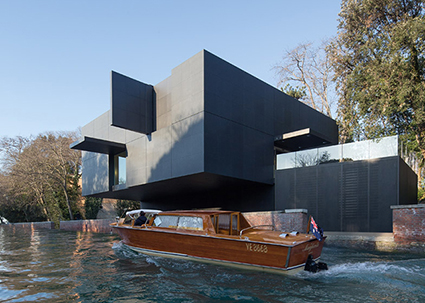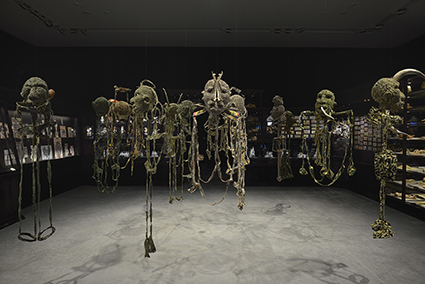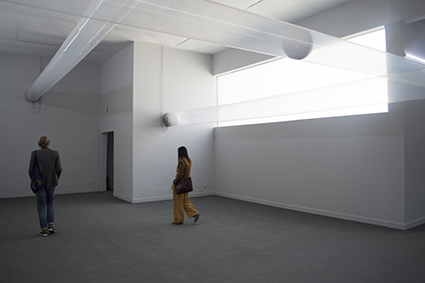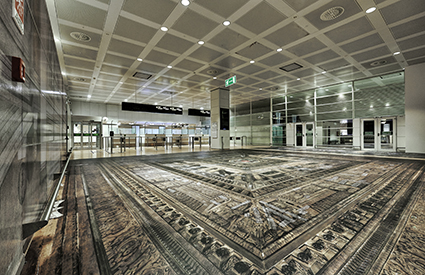 |
new Australian Pavilion |
The artist collective BGL hides the Canadian pavilion under scaffolding, transforming the building’s entrance into a tiny corner store. From the scaffolding, we are invited to drop coins through a maze into the glass windows. These windows—an important element of the Archimedean spiral-inspired structure—no longer function as the building’s exterior, but rather as an element of play within. Similarly, Israel’s Tsibi Geva drapes their pavilion under a grid of more than a thousand tyres—a coating that evokes danger in both sight and smell.
Leaving the exterior untouched, Austria’s Heimo Zobernig transforms his national pavilion’s distinctive arches and multi-level floor into a pared-back space. The 1930s building was designed by Joseph Hoffman and Robert Kramreiter, and is celebrated for its innovations in early Modernist gallery design. One of the key practical design characteristics is the diffused natural light source, which Zobernig has blocked with a low black ceiling and coupled with an equally oppressive floor. We are denied all reference to the already relatively minimal interior. Without the few distinctive features, we focus on the empty space and, amusingly, the expressions of the confused visitors who wander around the building looking for the artwork. It’s a very different experience to the narrow maze-like structure built by Austria’s 2011 representative, Markus Schinwald. Like Zobernig, he viewed the high ceiling, central raised entrance and long split interior as problematic, installing white painted ply to block both the ceiling and exterior approach. The notion that their building is ‘difficult’ to work with seems to be fairly consistent across many of the pavilions and, paradoxically, these ‘problems’ have inspired some engaging installations in response.
 |
Fiona Hall, All the Kings Men (2014-15), Australian Pavilion photo Christian Corte,courtesy the artist and Roslyn Oxley9 Gallery, Sydney |
Some of the more aggressive interactions with these buildings could be considered negative, but perhaps they simply communicate underlying cultural anxieties. The pavilions carry societal baggage—both positive and negative—having been designed or adapted according to the fashions, values and aspirations of the day. The USA’s 1930 Neo-Palladian building, for instance, reflects a certain cultural conservatism, while the redesign of the Greek and German pavilions in the same period contain nationalistic themes in line with their politics.
Australia’s former pavilion (architect Philip Cox, 1988) with its humble curved corrugated iron roof and wooden deck, was distinctly Australian. Its replacement (Denton Corker Marshall, 2015)—a mysterious solid black cubic structure that stands apart from its neighbours—is indicative of the image Australia now wants to project. The original was always described as temporary; however, the majority of the buildings within the Giardini were built in the spirit of impermanence and it’s only in the last 20 or so years that the buildings have remained fairly static. Those built in the early 20th century included apses and columns to accommodate sculptures, just as the architects of the new Australian pavilion have created a white cube in the name of ‘neutrality.’ The simple flat-walled interior definitely gives the illusion of a blank slate—a very literal response to the constant criticism of the old pavilion’s ‘difficult’ two-tiered space, which in itself inspired a work by Daniel von Sturmer in the 2007 Biennale.
 |
Helmo Zobernig installation, Austrian Pavillion, 2015 photo Henry Hawthorne |
There are 30 permanent national pavilions within the main Giardini site, while 30 countries have temporary ‘pavilions’ at the biennale’s other key site, the Arsenale. The remaining 31 have established temporary exhibition spaces around the city in palaces, shop fronts and churches. The allocation of permanent Giardini space is undeniably political. The first pavilions were allocated to colonial powers like Belgium in the early 20th century, and today, the list of represented countries largely mirrors real life global power. A site within the Giardini carries prestige, a guaranteed audience and in the opening three days it is the first place the media flocks to. But for countries without these sought-after sites, the opportunity to choose a location can be used strategically; New Zealand’s artists, for example, have consistently demonstrated the benefits of working outside these permanent spaces.
New Zealand is a relative newcomer to the Venice Biennale, participating for the first time in 2001. While many countries excluded from the Giardini set up pavilions in the snaking Arsenale warehouse, the sites chosen by New Zealand in recent years have either been specific to the artwork or used to enhance elements in it. Michael Parekowhai’s 2011 contribution and Francis Upritchard’s 2009 work used elements of their grand surroundings strategically and sympathetically. Upritchard’s petite figures, for instance, were installed in the rooms of an ornate neo-classical palace. Placed on simple tables, some of the colourful human figures gazed into the room’s cloudy mirrors, but were not site-specific per se. They were sensitive to their surroundings, and in turn, the environment subtly altered and enhanced the artist’s work.
 |
Secret Power, Simon Denny, Marco Polo Airport photo Paolo Monello |
As Denny’s site-specific artwork demonstrates, for countries excluded from the Giardini ‘club,’ Venice provides a rich source of sites for critical engagement. However, no country would give up a spot in the Giardini. The location brings much-desired media attention and a guaranteed audience, which, in an art world dominated by marketing and hype, trumps ease and flexibility of site every time. The inflexibility and ‘difficult’ spaces consistently cited by artists working within the Giardini, is not necessarily a negative; after all, these loaded spaces have inspired some of the most interesting artworks of this year’s biennale. The Giardini’s history is fascinating; not only does it map a century of cultural and political power, it has also survived fascism and contains an unparalleled mix of architectural styles that trace the aspirations of countries over time. Difficult or not, it’s a site that begs for artistic response.
Venice Biennale 2015, 9 May-22 Nov
Hobart-based writer, artist and independent researcher Lucy Hawthorne completed a PhD on site-specific art in Australia’s public museums in 2013, and is working on her first book. She is currently on a residency at the Cité Internationale des Artes in Paris, researching the relationship between art and architecture in pre-Modern buildings in order to better understand contemporary site-specific art practice.
RealTime issue #127 June-July 2015 pg. 52-53
© Lucy Hawthorne; for permission to reproduce apply to [email protected]








 back
back